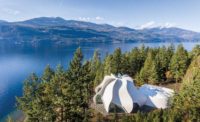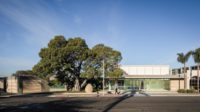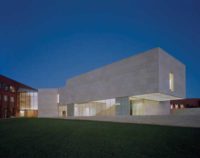The new Audain Art Museum in Whistler, British Columbia, is the antithesis of the throbbing ski town around it, with its chain stores fashioned as folksy alpine chalets. The highly abstract structure, designed by Vancouver-based Patkau Architects, defers to the surrounding terrain and its wooded site. Whistler’s civic leaders have long been trying to diversify their resort economy and its correlated theme-park architecture, and this museum focused on regional art could be the catalyst that brings a new crowd and a layer of sophistication to the city.
Additional Information:Jump to credits & specifications
The museum’s primary mandate is to display the personal collection of Vancouver developer and arts patron Michael Audain, whose holdings range from northwest coast art from the 18th century to cutting-edge contemporary works. The municipality provided the land for the museum in the hopes that the building would serve as a cultural oasis and an enclave for quiet contemplation within the bustle of a sporting town. Their hopes are well-placed.
Led by principals John and Patricia Patkau and project architect David Shone, the museum was partly inspired by two existing museums: the Louisiana outside of Copenhagen, and the Valkhof in Nijmegan, Netherlands, by UNStudio, both of which have main circulation paths overlooking natural settings. But the conceptual prototype was the firm’s own 2011 Linear House, which is a slender bar flanked by rows of trees on nearby Salt Spring Island. But for the museum, the architects added a second bar, creating a 56,000-square-foot structure with a splayed L-configuration that includes a discrete wing for travelling exhibitions.
Although John Patkau modestly refers to this plan as “simple,” the logistical and programmatic requirements were in fact daunting. Chief among these challenges was a design brief stipulation that the permanent collection not be exposed to any daylight, a problematic restriction for a building that would display artwork heavily informed by the regional landscape. In addition, the client insisted on preserving as many trees as possible, which limited the footprint to a naturally occurring void within the forested lot. But this spot was prone to flooding of the type that can often carry with it melting ice and snow and other debris.
The solution is a bridgelike structure with a sloped roof and walls clad in dark steel. Most of the structure comprises two stories floating over the site, resting on two triangular concrete monoliths that look and act like bridge abutments and four support cores that enclose shipping and receiving, circulation, and other services. (“We’ve been described as an ‘art ark,’ ” says Darrin Martens, the museum’s chief curator.) Its steeply pitched roof, designed to shed snow in winter, also minimizes its bulk within the forest: this is a building that projects serenity.
The main entrance, approached from an elevated walkway, is defined by wings of slatted hemlock, crafted by local carpenters with the precision of fine joinery; it feels like walking into a giant origami volume. Once inside, the visitor beholds a window-wall tableau of trees, highlighting the strong ties between nature and the collection. From there, the foyer and circulation path allow museumgoers to instantly reconnect with the building’s verdant setting. The main route through the building has on one side a series of galleries and on the other side a panoramic view of the dramatic landscape that has informed or inspired much of the artwork within.
The gallery sequence begins with historic aboriginal art. This room is characterized by subdued lighting and dark-gray walls, the somber hue conveying the spiritual, organic context of this work. From there, the visitor has the choice of either stepping back into the glazed corridor or continuing onto a series of interconnected white-walled galleries focusing on recent and contemporary British Columbian work.
The upper floor contains galleries and administrative space. Though largely windowless, these staff areas are made congenial by strategic skylighting, an all-white palette, and sloped walls (generated by that steeply angled roof), which gives them the feeling of high-end artist’s lofts. This level also houses utilitarian rooms of exceptionally generous size, for packing, unpacking, storing, and restoring works of art. “These are the spaces that we as curators fought tooth and nail for,” says Martens.
Built on the historic lands of the Squamish-Lillouet aboriginal peoples, the museum seems as though it has always stood here, respectful of the land and of the culture of its original inhabitants. Its rich conceptual underpinnings, elegant proportions, and careful detailing raise it to the level of a landmark.
CreditsArchitect: Patkau Architects Inc
Personnel in architect's firm who should receive special credit: John Patkau, Patricia Patkau, David Shone, Michael Thorpe, Mike Green, Marc Holland, Com Koroluk, Dimitri Koubatis, Tom Schroeder, Luke Stern, Peter Suter, David Zeibin
Engineers Structural: Equilibrium Consulting
Consultants Landscape: PFS Studio / Tom Barratt
General contractor: Axiom Builders
Photographer: James Dow / Patkau Architects
|
SpecificationsStructural System Concrete Foundations Manufacturer of any structural components unique to this project: Cast Connex - Structural Steel - Scorpion Yielding Connections Exterior Cladding Metal panels: Pocklington Building Systems Standing Seam Metal/glass curtain wall: Kawneer Moisture barrier: Epro; Cosella-Dorken; Bakor/Henry; Colbond Curtain wall: Kawneer Roofing Elastomeric: Soprema Metal: Pocklington Building Systems Standing Seam Glazing Glass: Guardian Glass Skylights: Kawneer Doors Entrances: Kawneer; CRL Metal doors: Shanahans Sliding doors: Stanley Dura-Glide Other doors: Overhead Door Company Stormtite Overhead Coiling Doors Hardware Locksets: Sargent Closers: Sargent; Dorma Exit devices: Sargent; Von Duprin; CRL Pulls: Canadian Builders Hardware Security devices: Cobra Integrated Systems Interior Finishes Solid surfacing: Dupont Corian Floor and wall tile: Lea Ceramiche - Floors Carpet: Kinetex/Accelerate Lighting Interior ambient lighting: Lighting Services Inc.; Element; MP; Soraa; Erco; Dasal; BK Lighting; LED Linear; Twice Bright Conveyance Elevators/escalators: Richmond Elevator Plumbing Stern Williams |



















Post a comment to this article
Report Abusive Comment